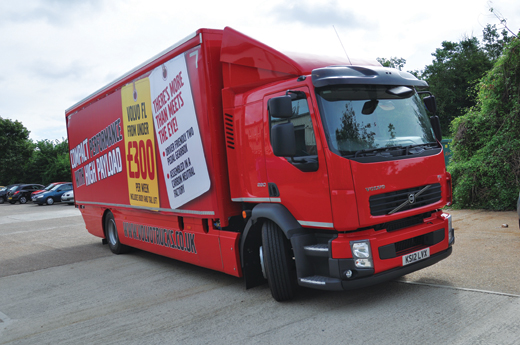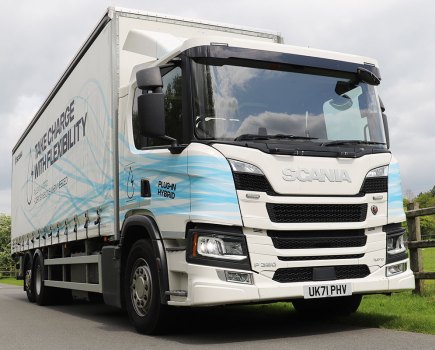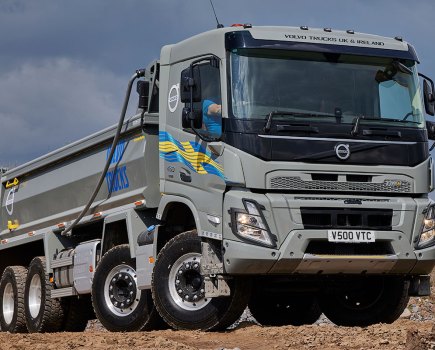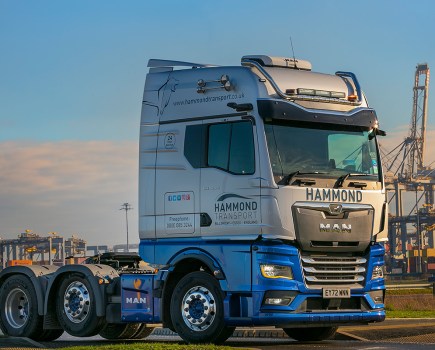
Need an 18-tonner that can carry a 10 tonne-plus payload, bodied and fitted with a tail-lift?
By Steev Hayes • Photography Steev Hayes
The truck in question is Volvo’s FL-290. The FL-series are 4×2 rigids available in 12, 15, 16 or 18 tonne chassis.
Clearly a rigid at those weights is going to be an urban specialist, and that requires it to be nimble and agile for the city, as well as being well-suited to stints running on the highway and motorway.
Engines available are 240, 260 or 290 bhp, which at any of these gross vehicle weights, is going to be more than adequate for almost any given task. Transmissions listed are six-speed or nine-speed manual gearboxes, an Allison automatic, or the six-speed, ZF-produced automated transmission, dubbed I-Sync.
The FL series Volvo is suited to (and can be bodied for) almost any function or duty cycle. You want a small urban refuse truck? Yep, can do. A dropside bodied chassis with grab or crane? Check. Box or curtainsider for urban deliveries? No bother.
And the chassis has been designed with operating in and coping with the busy and congested urban environment in mind. The cab is built tough – don’t forget trucks built in Sweden must comply with the country’s stringent impact tests, claimed to be the world’s toughest. Should you have a prang, the deformable steering wheel, energy-absorbing materials, injury-safe pedals and fire resistant interior trim should keep you safe. The Front Under-run Protection (FUP) design will keep others safe, while if you have a ding in a confined space, or a nerd shunts the front end, causing superficial damage, the sturdy three-part bumper has been designed for easy repair. The most vulnerable parts – the corners – are made from steel, while the centre section is plastic. The bumper is designed to collapse on impact, absorbing energy in the event of a front-end shunt, protecting all involved, particularly car occupants.
The truck can be completely mirrored up, too, to suit a multitude of work. Close quarter mirrors for drivers who regularly have to cope with manoeuvring in tight spots with lots of obstacles around them are available over and above the standard-fit compulsory mirrors.
For those same drivers, a kerb-side view mirror is available as an option, there’s an extra window available on the passenger in the Medium cab, and an extra nearside window on the Medium cab.

On the road – Volvo offered a 4×2 FL-290 4×2 rigid, fitted with a Bevan curtainsider body and a 1500 kg Dhollandia Tuckaway tail lift for road testing. Kerb weight is stated as being 7870 kg, which gives a payload of just over 10 tonnes (10130 kg).
Unsurprisingly, the Volvo FL-290 Medium cab is designed to suit almost any shape or size driver, and is particularly suited to urban work. The doors open up a full 90 degrees, and the cab is nice and low for drivers on multi-drop work who need to climb in and out of the cab a gazillion times a day. The steps are angled like stairs, which makes getting in and out of the cab carrying items a lot easier, particularly if the driver stows the steering wheel at its most forward setting and dumps the air on the driver’s seat. The seats are multi-function/setting, and absorb the punishment dished out to drivers and passengers in the truck while travelling on today’s less that perfect road surfaces.
Cross-cab access isn’t part of the design of this cab, as it has an engine hump (with a low cab, that’s inevitable). But it is fairly easy to get yourself across from one side to the other should you need to.
With the I-Sync automated transmission, it’s a simple case of selecting drive with the stubby, steering column-mounted lever, release the parking brake and off you go. A two-pedal set-up, the driver can leave the electronics to look after the gears and concentrate on the driving. We put the truck through its paces on a mixed route that included dual-carriageway, motorway, some A-roads and took us through a couple of busy towns and onto a trading estate. That’s typical territory for this type of truck – and it proved to be ideally suited.
The 290 stretched is legs on the motorways and dual carriageways, but was equally at home on more narrow and twisting A-roads in Warwickshire, and crawling around trading estates.
It has a good lock-to-lock steering and is highly manoeuvrable in tight spots. On the road, inside the cab is quiet enough to hold a conversation, but the problem with that is the driver can pick up on other noises – in this instance the wind whistling around the outside of the cab.
The hill hold function was kept switched on, and proved invaluable running in the towns and trading estates, and on the couple of occasions we were brought to a halt because of roadworks on country roads. Just keeping the foot on the brake pedal until the coast is clear, then off the brake and onto the accelerator pedal and you are away. No need to mess with the parking brake. That’s really useful on a truck like this.
The engine revs are kept well within the green band, and the automated transmission works well, even under pressure. Being a six-speed ’box, the step between gears is quite long, so the truck goes up through the gears one-by-one. But it will skip-shift going down through the gears for extra slowing power if necessary.
On one climb, the transmission did a double rev when changing down, which ensured the gearchange was carried out very smoothly, with no lurch as the gearbox did its job. At times, the engine revs are kept in the green, while at others, the message from the transmission is ‘let’s get up and over this hill as soon as possible’, and the revs rose further into the blue band to speed up the process.
Obviously one factor that is necessary nowadays is to be able to keep pace with traffic. And this Volvo does that with verve. It’s quickly up to speed, so getting out of junctions and crossing busy roads and roundabouts isn’t a risk or a chore.
The ergonomically-designed work area makes for a pleasant environment for the driver, and the switches and dials are all logically laid out and are within easy reach of the driver’s hands.

Pushing the truck into corners proved handling is up to scratch, and braking is exceptionally good. On some of the longer downgrades, which admittedly weren’t extreme, the engine brake lever was pulled down – pulling it back to the maximum alerts the transmission that you need to slow things down, and it downshifts to take the revs up and increase slowing power. Using it soon becomes second nature.
This cab was the Medium version, so is probably not the kind drivers running on those previously mentioned types of operations would necessarily have – day cabs are the likely candidates here. But this cab might be useful for the occasional night out. It’s dutifully recorded as being a ‘rest cab’. Ah, that old chestnut! Many’s the governor who’s bought ‘rest cabs’ fitted some nice curtains and pressed them into service on longer distance work! However, there’s quite a bit of useful storage, and the bunk is nice and wide and well sprung. So a night or two out in this would not be a problem. The only downside being the need to fold both seats forward and flat before the bed can be put into place. So it is one of those bunks that needs setting up each time you use it. But lowering the bunk has been made easy by way of two steel spring clips that the driver simply has to lift to uncatch it. Stowing again, you just raise the bunk (which folds flat against the rear wall of the cab) and press them home, the clips springing over the edge of the bunk and clicking into place. You can imagine a driver taking a ‘45’ in this bunk, then getting back in the saddle to finish the day’s work, fresh as a daisy.
Verdict: How do we rate the FL? It’s not everyone’s cup of tea, but we reckon most drivers given one of these to do say, urban deliveries, skip work, or jobs along those lines, would be happy enough.
The Medium ‘rest cab’ does give drivers a bit of extra space, and the bunk would be handy under certain circumstances. Storage is probably best described as adequate, although the door pockets are tiny.
On-road handling is very good, the brakes bite well, and don’t over-react, and the 290 engine allows the driver to keep up a decent pace – essential for this type of rig.
Ride was harsh, but the seats kept the driver fairly well insulated against the deep potholes and drains that peppered the route and were unavoidable where there was oncoming traffic on the narrower country roads.
The quietness in the cab was proven because we could hear wind noise from the outside. The problem is, the quieter manufacturers make trucks, drivers are going to start picking up extraneous noises, which are beyond anyone’s control!
The FL is a base type of truck that will be used in a harsh environment, and not always with the best of care. They are prone to knocks and scrapes, and Volvo has done a good job in preparing it for the worst as far as they can.
Overall, the truck is a treat to drive and, as for urban work and inter-city runs, it ticks all the boxes






